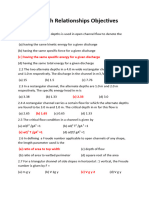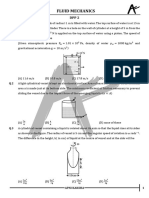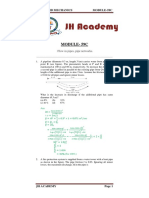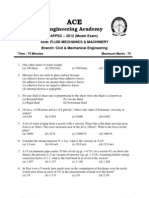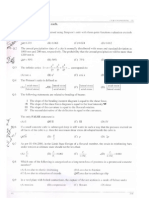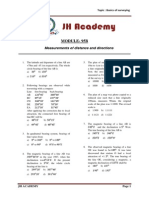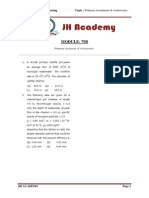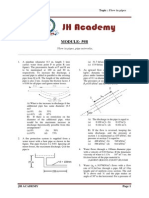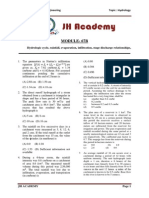Module-60B: Sub: Fluid Mechanics Topic
Module-60B: Sub: Fluid Mechanics Topic
Uploaded by
Jamie SchultzCopyright:
Available Formats
Module-60B: Sub: Fluid Mechanics Topic
Module-60B: Sub: Fluid Mechanics Topic
Uploaded by
Jamie SchultzOriginal Description:
Original Title
Copyright
Available Formats
Share this document
Did you find this document useful?
Is this content inappropriate?
Copyright:
Available Formats
Module-60B: Sub: Fluid Mechanics Topic
Module-60B: Sub: Fluid Mechanics Topic
Uploaded by
Jamie SchultzCopyright:
Available Formats
Sub: Fluid Mechanics
Topic : Boundary layer
MODULE- 60B
Concept of boundary layer and its growth.
___________________________________________________________________ 1. Velocity distribution in a boundary layer flow over a plate is given by = 1.5 where, = y/; y is the distance measured normal to the plate; is the boundary layer thickness; and is the maximum velocity at y = . If the shear stress , acting on the plate is given by = K( )/ where, is the dynamic viscosity of the fluid, K takes the value of (A) 0 (B) 1 (C) 1.5 (D) None of the above
2. A flat plate is kept in an infinite fluid medium. The fluid has a uniform freestream velocity parallel to the plate. For the laminar boundary layer formed on the plate, pick the correct option matching Columns I and II. Column I P. Boundary layer thickness Q. Shear stress at the plate. R. Pressure gradient along the plate. Column II 1. decreases in the flow direction 2. Increases in the flow direction 3. remains unchanged Codes: P Q R (a) (b) (c) (d) 3. 1 2 1 2 2 2 1 1 3 2 1 3 (a) (c) 4. 0.50 m (b) 1.00 m (d) 0.80 m 1.25 m
The flow of water (mass density = 1000 kg/m3 and kinematic viscosity = 10-6 m2/s) in a commercial pipe, having equivalent roughness ks as 0.12 mm, yields an average shear stress at the pipe boundary = 600 N/m2. The value of ks/ being the thickness of laminar sub-layer) for this pipe is (A) 0.25 (B) 0.50 (C) 6.0 (D) 8.0
The thickness of the laminar boundary layer on a flat plate at a point A is 2 cm and at a point B, 1m downstream of A, is 3 cm. What is the distance of A from the leading edge of the plate?
JH ACADEMY
Page 1
You might also like
- 44BDocument7 pages44BJamie SchultzNo ratings yet
- ME 2135E - Fluid Mechanics II - Take Home Test: Time Allocated: 2 Hours To 2 Hours and 30 MinutesDocument5 pagesME 2135E - Fluid Mechanics II - Take Home Test: Time Allocated: 2 Hours To 2 Hours and 30 Minutesrayni46100% (1)
- 44CDocument9 pages44Cjhacademyhyd100% (3)
- Ce 2007Document15 pagesCe 2007GTSNo ratings yet
- GATE Civil Engineering 2007Document18 pagesGATE Civil Engineering 2007Mithun MohanNo ratings yet
- Sde 2014Document18 pagesSde 2014Abhishek SainiNo ratings yet
- Gate Question Papers Download Civil Engineering 2003Document18 pagesGate Question Papers Download Civil Engineering 2003M.S.MirNo ratings yet
- ObjectivesDocument17 pagesObjectivesBN PAVAN KUMARNo ratings yet
- 44C PDFDocument16 pages44C PDFLokesh Yadav100% (1)
- Group Assignment IIIDocument7 pagesGroup Assignment IIIlelisagetachew90No ratings yet
- Fluid Mechanics (XE (B) ) PDFDocument5 pagesFluid Mechanics (XE (B) ) PDFLucas SchroederNo ratings yet
- Open Channel (Rakshith)Document12 pagesOpen Channel (Rakshith)SudeepSMenasinakaiNo ratings yet
- IES OBJ Civil Engineering 2007 Paper IIDocument15 pagesIES OBJ Civil Engineering 2007 Paper IISudharsananPRSNo ratings yet
- Live Class Notes Avnish Sir 26-11-2020Document44 pagesLive Class Notes Avnish Sir 26-11-2020Rakesh KumarNo ratings yet
- Topic-Wise GATE1Document32 pagesTopic-Wise GATE1CHHAVI AGARWAL0% (1)
- GATE 2022 Engineering Sciences XE Fluid Mechanics: XE-B (Q.22 - Q.30 Carry ONE Mark Each)Document16 pagesGATE 2022 Engineering Sciences XE Fluid Mechanics: XE-B (Q.22 - Q.30 Carry ONE Mark Each)Ishwar SinghNo ratings yet
- Acronis True Image 11.8053Document6 pagesAcronis True Image 11.8053Ranjie MolinaNo ratings yet
- DPP - 02 - Fluid NJ - 247Document3 pagesDPP - 02 - Fluid NJ - 247Shivek agrawalNo ratings yet
- Module 44BDocument8 pagesModule 44BkamalnitrrNo ratings yet
- Government College of Engineering Kalahandi, Bhawanipatna: Test-IiDocument4 pagesGovernment College of Engineering Kalahandi, Bhawanipatna: Test-IiAMIT KUMARNo ratings yet
- S8 Xe-BDocument11 pagesS8 Xe-BmnraveeNo ratings yet
- UNIT-9 Q'S - 8-5-20-Dr.P.V.RDocument4 pagesUNIT-9 Q'S - 8-5-20-Dr.P.V.Rbaswani geetheshNo ratings yet
- Soal Tutorial 3 MS3121 Mekanika FluidaDocument2 pagesSoal Tutorial 3 MS3121 Mekanika Fluidai need documentsNo ratings yet
- 0910sem2 Me2135Document6 pages0910sem2 Me2135brugelionNo ratings yet
- ME335 F2012 Quiz11Document2 pagesME335 F2012 Quiz11Catherine AndersonNo ratings yet
- Paper 2222Document16 pagesPaper 2222Abhijeet GholapNo ratings yet
- 58CDocument3 pages58CAjay MalikNo ratings yet
- Obj CivilEngineering 2007paper IIDocument15 pagesObj CivilEngineering 2007paper IIakuril0% (1)
- 59CDocument4 pages59CAjay MalikNo ratings yet
- FM GateDocument50 pagesFM GateIndhira Devi PNo ratings yet
- Chemical Etching: Created in COMSOL Multiphysics 5.4Document14 pagesChemical Etching: Created in COMSOL Multiphysics 5.4Василь ІванинаNo ratings yet
- GATE Agricultural Engineering Paper 2016Document14 pagesGATE Agricultural Engineering Paper 2016kanthaNo ratings yet
- Assignment ME401 For GATE PreparationDocument26 pagesAssignment ME401 For GATE Preparationhameem mohdNo ratings yet
- FM AssignmentDocument5 pagesFM AssignmentPRIYANSH JNo ratings yet
- Open Channel Flow PDFDocument54 pagesOpen Channel Flow PDFChristy Mae LabajoNo ratings yet
- GATE Fluid Mechanics Paper 2018Document5 pagesGATE Fluid Mechanics Paper 2018MOHANKUMAR.P.N MIT-AP/MECHNo ratings yet
- Appsc 2012 Fluid Mechanics and MachineryDocument8 pagesAppsc 2012 Fluid Mechanics and Machineryajaykrishna_990% (1)
- Assignments IIIrd YearDocument34 pagesAssignments IIIrd Yearsirsa11No ratings yet
- 14 Years GATE Questions 1997-2014Document289 pages14 Years GATE Questions 1997-2014Enoch Arden80% (10)
- CHEN 2102 Chemical Engineering Fluid MechanicsDocument5 pagesCHEN 2102 Chemical Engineering Fluid MechanicsSouvik AriNo ratings yet
- TSPSC Aee Mocktest-1 PDFDocument26 pagesTSPSC Aee Mocktest-1 PDFSantosh YelagandulaNo ratings yet
- Live Class Notes Avnish Sir 01-12-2020Document99 pagesLive Class Notes Avnish Sir 01-12-2020Rakesh KumarNo ratings yet
- Assignment 1Document3 pagesAssignment 1Vandit GoyalNo ratings yet
- 72BDocument3 pages72BTracy WilsonNo ratings yet
- Gate Civil EngineeringDocument33 pagesGate Civil EngineeringFarhad ObaidNo ratings yet
- 2203ENG - Final Exam 2012 - JNNDocument6 pages2203ENG - Final Exam 2012 - JNNMatthewNo ratings yet
- Btech Ce 4 Sem Hydraulics and Open Channel Flow 011410 2013Document1 pageBtech Ce 4 Sem Hydraulics and Open Channel Flow 011410 2013sarojkrmahuwanNo ratings yet
- Answer Any Two QuestionsDocument11 pagesAnswer Any Two QuestionsKirtismita TalukdarNo ratings yet
- NDPN in QatarDocument13 pagesNDPN in QatarjamalNo ratings yet
- 2nd Power Fluid B 2011 Final With Model AnsweDocument7 pages2nd Power Fluid B 2011 Final With Model AnsweS.A. BeskalesNo ratings yet
- Gate 2004 PDFDocument37 pagesGate 2004 PDFAkash Km SinghNo ratings yet
- Civil Engineering Department: Syllabus For PHD Entrance Exam in Civil Engineering Environmental EnggDocument5 pagesCivil Engineering Department: Syllabus For PHD Entrance Exam in Civil Engineering Environmental EnggGupta JiNo ratings yet
- Civil Engineering Gate Previous Papers 2012-2000Document155 pagesCivil Engineering Gate Previous Papers 2012-2000bhkedarNo ratings yet
- ChE 2O04 Winter 2016 - Midterm R3Document10 pagesChE 2O04 Winter 2016 - Midterm R3kmcNo ratings yet
- Aerodynamics Question BankDocument39 pagesAerodynamics Question BankSeeandgrow ByabdulsamadNo ratings yet
- Reviews in Computational ChemistryFrom EverandReviews in Computational ChemistryAbby L. ParrillNo ratings yet
- O level Physics Questions And Answer Practice Papers 2From EverandO level Physics Questions And Answer Practice Papers 2Rating: 5 out of 5 stars5/5 (1)
- 96BDocument3 pages96BJamie SchultzNo ratings yet
- Module-98B: Plane Table SurveyingDocument1 pageModule-98B: Plane Table SurveyingJamie SchultzNo ratings yet
- Module-99B: Errors and AdjustmentsDocument1 pageModule-99B: Errors and AdjustmentsJamie SchultzNo ratings yet
- 95BDocument2 pages95BJamie SchultzNo ratings yet
- 89BDocument2 pages89BJamie SchultzNo ratings yet
- 87BDocument5 pages87BJamie Schultz100% (1)
- Module 85BDocument1 pageModule 85BJamie SchultzNo ratings yet
- Module-79B: Sub: Environmental Engineering TopicDocument1 pageModule-79B: Sub: Environmental Engineering TopicJamie SchultzNo ratings yet
- Module-82B: Sub: Environmental Engineering TopicDocument1 pageModule-82B: Sub: Environmental Engineering TopicJamie SchultzNo ratings yet
- Module 83BDocument1 pageModule 83BJamie SchultzNo ratings yet
- Module-74B: Types of Irrigation System, Irrigation Methods. Water Logging and Drainage, Sodic SoilsDocument1 pageModule-74B: Types of Irrigation System, Irrigation Methods. Water Logging and Drainage, Sodic SoilsJamie SchultzNo ratings yet
- 78BDocument3 pages78BJamie SchultzNo ratings yet
- 76BDocument4 pages76BJamie SchultzNo ratings yet
- Module-69B: Flood Estimation, Reservoir Capacity, Reservoir and Channel RoutingDocument1 pageModule-69B: Flood Estimation, Reservoir Capacity, Reservoir and Channel RoutingJamie SchultzNo ratings yet
- 68BDocument5 pages68BJamie Schultz100% (1)
- Module-77B: Basic Unit Operations and Unit Processes For Surface Water Treatment, Distribution of WaterDocument1 pageModule-77B: Basic Unit Operations and Unit Processes For Surface Water Treatment, Distribution of WaterJamie SchultzNo ratings yet
- 59BDocument2 pages59BJamie SchultzNo ratings yet
- 67BDocument5 pages67BJamie SchultzNo ratings yet
- 62BDocument2 pages62BJamie SchultzNo ratings yet
- 59BDocument2 pages59BJamie SchultzNo ratings yet
- Module-57B: Potential Flow, Applications of Momentum and Bernoulli's EquationDocument1 pageModule-57B: Potential Flow, Applications of Momentum and Bernoulli's EquationJamie SchultzNo ratings yet







